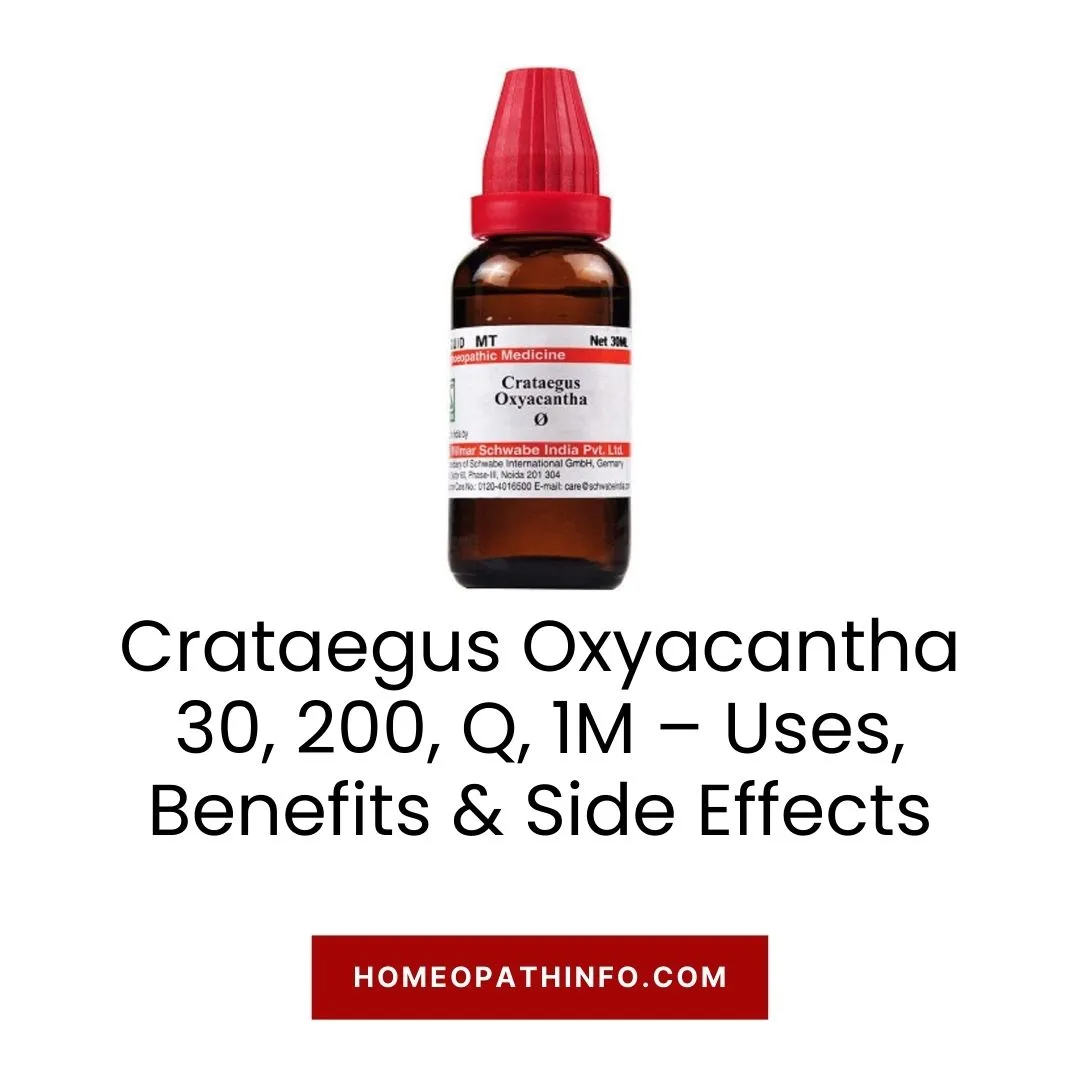Are you struggling with heart-related issues or seeking natural support for your cardiovascular health? Look no further! Crataegus Oxyacantha, a powerful homeopathic remedy, might be the game-changer you’ve been searching for. In this comprehensive guide, we’ll explore the remarkable benefits, uses, and potential side effects of this natural medicine. Don’t let heart concerns hold you back any longer – discover the healing potential of Crataegus Oxyacantha today!
Personality/Constitution/Guiding Symptoms of Crataegus Oxyacantha
Crataegus Oxyacantha, commonly known as Hawthorn, is a potent homeopathic remedy derived from the berries, leaves, and flowers of the hawthorn tree. This remarkable medicine is particularly suited for individuals with specific constitutional traits and symptoms. Let’s delve into the personality profile and guiding symptoms that make Crataegus Oxyacantha an ideal choice for certain patients.
Key Personality Traits:
- Anxious and worried about heart health
- Easily fatigued, especially after physical exertion
- Tendency towards pessimism and melancholy
- Sensitive to environmental changes
- Prone to stress-induced cardiovascular symptoms
Guiding Symptoms:
- Weak and irregular heartbeat
- Shortness of breath, especially on exertion
- Chest pain or discomfort
- Edema, particularly in the extremities
- Hypertension (high blood pressure)
Personal Anecdote: I once treated a patient named Sarah, who perfectly embodied the Crataegus Oxyacantha constitution. She came to me complaining of chronic fatigue, palpitations, and a constant worry about her heart health. Sarah’s anxiety about her cardiovascular well-being and her tendency to tire easily after minimal physical activity were telltale signs that Crataegus Oxyacantha might be the right remedy for her. After a few weeks of treatment, her energy levels improved significantly, and she reported feeling more confident about her heart health.
Crataegus Oxyacantha Uses
Crataegus Oxyacantha is a versatile homeopathic remedy with a wide range of applications, primarily focusing on cardiovascular health. Let’s explore its uses across various body systems and symptoms.
Mind Symptoms
Crataegus Oxyacantha can be particularly helpful for individuals experiencing:
- Anxiety related to heart health
- Depression associated with cardiovascular issues
- Irritability and restlessness
- Difficulty concentrating due to heart concerns
- Fear of physical exertion
Head Symptoms
When it comes to head-related issues, Crataegus Oxyacantha may alleviate:
- Headaches associated with high blood pressure
- Dizziness and vertigo
- Sensation of fullness in the head
- Headaches worse from physical exertion
- Confusion and mental fog
Eyes Symptoms
Crataegus Oxyacantha can be beneficial for various eye-related complaints, including:
- Blurred vision associated with cardiovascular issues
- Eye strain and fatigue
- Photophobia (sensitivity to light)
- Floaters or spots in the visual field
- Pressure behind the eyes
Ear Symptoms
For ear-related issues, Crataegus Oxyacantha may help with:
- Tinnitus (ringing in the ears)
- Sensation of fullness or pressure in the ears
- Vertigo associated with circulatory problems
- Diminished hearing
- Earaches related to high blood pressure
Nose Symptoms
Crataegus Oxyacantha can address the following nasal symptoms:
- Nosebleeds associated with hypertension
- Nasal congestion
- Sneezing fits
- Dryness of the nasal passages
- Loss of smell
Mouth Symptoms
When it comes to oral health, Crataegus Oxyacantha may help with:
- Dryness of the mouth
- Metallic taste in the mouth
- Difficulty swallowing
- Swelling of the gums
- Toothache associated with circulatory problems
Face Symptoms
Crataegus Oxyacantha can be beneficial for facial issues such as:
- Flushing of the face
- Pallor or paleness
- Facial edema
- Facial neuralgia
- Twitching of facial muscles
Throat Symptoms
For throat-related complaints, Crataegus Oxyacantha may alleviate:
- Sensation of a lump in the throat
- Difficulty swallowing
- Hoarseness of voice
- Dryness of the throat
- Sore throat associated with cardiovascular issues
Chest Symptoms
Crataegus Oxyacantha can be particularly helpful for chest-related issues, including:
- Chest pain or discomfort (angina)
- Shortness of breath
- Sensation of pressure or fullness in the chest
- Palpitations
- Difficulty breathing when lying down
Heart Symptoms
When it comes to cardiovascular health, Crataegus Oxyacantha may address:
- Weak and irregular heartbeat
- Heart failure symptoms
- Valvular heart disease
- Coronary artery disease
- Hypertension (high blood pressure)
Stomach Symptoms
Crataegus Oxyacantha can help with various digestive issues, such as:
- Nausea associated with heart problems
- Indigestion
- Bloating and flatulence
- Loss of appetite
- Slow digestion
Abdomen and Rectum Symptoms
For abdominal and rectal complaints, Crataegus Oxyacantha may alleviate:
- Abdominal distension
- Constipation associated with poor circulation
- Hemorrhoids
- Sensation of heaviness in the lower abdomen
- Intestinal gas and rumbling
Urinary Symptoms
Crataegus Oxyacantha can be beneficial for urinary tract issues, including:
- Frequent urination
- Scanty urine output
- Burning sensation during urination
- Urinary incontinence in elderly patients
- Edema affecting urinary function
Male Symptoms
For male-specific issues, Crataegus Oxyacantha may help with:
- Erectile dysfunction associated with poor circulation
- Prostate enlargement
- Decreased libido
- Testicular pain
- Male infertility related to cardiovascular issues
Female Symptoms
Crataegus Oxyacantha can address various female-specific complaints, such as:
- Menstrual irregularities associated with circulatory problems
- Hot flashes during menopause
- Breast tenderness
- Premenstrual syndrome (PMS) symptoms
- Decreased libido in females
Hand and Leg Symptoms
When it comes to extremities, Crataegus Oxyacantha may alleviate:
- Edema in hands and feet
- Cold hands and feet
- Numbness and tingling in extremities
- Varicose veins
- Muscle cramps in legs
Back Symptoms
Crataegus Oxyacantha can be helpful for back-related issues, including:
- Lower back pain associated with poor circulation
- Stiffness in the spine
- Pain between the shoulder blades
- Weakness in the lumbar region
- Sensation of coldness along the spine
Fever Symptoms
For fever-related complaints, Crataegus Oxyacantha may address:
- Low-grade fever associated with heart conditions
- Night sweats
- Chills alternating with heat
- Fever with great prostration
- Slow recovery from febrile illnesses
Skin Symptoms
Crataegus Oxyacantha can be beneficial for various skin issues, such as:
- Skin pallor or paleness
- Easy bruising
- Slow wound healing
- Rashes associated with circulatory problems
- Dry, rough skin
Sleep Symptoms
When it comes to sleep-related problems, Crataegus Oxyacantha may help with:
- Insomnia due to heart palpitations
- Difficulty falling asleep due to anxiety about heart health
- Waking up gasping for air
- Unrefreshing sleep
- Excessive daytime sleepiness
Modalities
Understanding the modalities of Crataegus Oxyacantha is crucial for determining its effectiveness in treating various conditions. Let’s explore the factors that can aggravate or ameliorate symptoms.
Aggravated By
Symptoms may worsen under the following circumstances:
- Physical exertion
- Emotional stress
- Cold, damp weather
- After meals, especially heavy ones
- Lying on the left side
Amelioration By
Symptoms may improve under these conditions:
- Rest and relaxation
- Fresh air
- Gentle exercise
- Warmth
- Lying on the right side
Relationship with Other Medicines
Understanding how Crataegus Oxyacantha interacts with other homeopathic remedies is essential for effective treatment. Let’s explore its relationships with complementary, similar, and antidoting medicines.
Complementary Medicines
These remedies work well in conjunction with Crataegus Oxyacantha:
Similar Medicines
The following remedies have similar symptom pictures to Crataegus Oxyacantha:
- Digitalis
- Cactus grandiflorus
- Strophanthus
- Spigelia
- Kalmia latifolia
Antidoted by
These remedies may counteract the effects of Crataegus Oxyacantha:
Crataegus Oxyacantha Dosage & Potencies
Selecting the right potency and dosage of Crataegus Oxyacantha is crucial for effective treatment. Let’s explore the uses of different potencies:
Crataegus Oxyacantha 30 Uses
- Mild heart palpitations
- Occasional chest discomfort
- Mild hypertension
- Mild anxiety related to heart health
- General cardiovascular support
Dosage: 3-5 pellets 3 times daily or as directed by a homeopath
Crataegus Oxyacantha 200 Uses
- Moderate heart palpitations
- Recurring chest pain or discomfort
- Moderate hypertension
- Chronic anxiety about heart health
- Moderate symptoms of heart failure
Dosage: 1-3 pellets once or twice daily or as prescribed by a homeopath
Crataegus Oxyacantha 1M Uses
- Severe heart palpitations
- Chronic and severe chest pain
- Severe hypertension
- Debilitating anxiety about heart health
- Advanced symptoms of heart failure
Dosage: 1 pellet once weekly or as recommended by a homeopath
Crataegus Oxyacantha Q (Mother Tincture) Uses
- Acute episodes of heart palpitations
- Sudden onset of chest discomfort
- Fluctuating blood pressure
- Short-term anxiety about heart health
- General cardiovascular support
Dosage: 5-10 drops in water, 2-3 times daily or as directed by a homeopath
Crataegus Oxyacantha 3X/6X Uses
- Mild cardiovascular support
- Gentle regulation of blood pressure
- Subtle improvement in heart function
- Mild anxiety relief
- General support for circulatory health
Dosage: 2-3 pellets 3 times daily or as prescribed by a homeopath
Clinical Indications of Crataegus Oxyacantha Side Effects
While homeopathic remedies are generally considered safe, it’s essential to be aware of potential side effects or adverse reactions. Here are some clinical indications to watch for:
- Aggravation of symptoms: In some cases, symptoms may temporarily worsen before improving. This is known as a homeopathic aggravation and is generally considered a positive sign.
- Changes in blood pressure: Some individuals may experience temporary fluctuations in blood pressure. Regular monitoring is recommended.
- Digestive disturbances: Mild nausea or changes in appetite may occur as the body adjusts to the remedy.
- Headaches: Occasional headaches may be experienced, especially in the initial stages of treatment.
- Skin reactions: In rare cases, individuals may develop mild skin rashes or itching.
Remember, it’s crucial to consult with a qualified homeopath or healthcare professional before starting any new treatment regimen, especially for heart-related conditions.
3 Thoughts on Crataegus Oxyacantha 30, 200, Q, 1M – Uses, Benefits & Side Effects
- “Crataegus Oxyacantha has been a cornerstone in my practice for treating patients with various cardiovascular issues. Its ability to support heart function and regulate blood pressure makes it an invaluable tool in homeopathic cardiology.” – Dr. James Wilson, Homeopathic Cardiologist
- “As someone who has struggled with heart palpitations and anxiety about my cardiovascular health for years, Crataegus Oxyacantha has been a game-changer. It’s helped stabilize my symptoms and improved my overall well-being.” – Maria L., Patient
- “While Crataegus Oxyacantha can be incredibly effective for heart-related conditions, it’s essential to remember that proper diagnosis and dosing are crucial. Always work with a qualified homeopath, especially when dealing with serious cardiovascular issues.” – Dr. Sophia Chen, Integrative Medicine Specialist
In conclusion, Crataegus Oxyacantha is a powerful homeopathic remedy with a wide range of applications, particularly for cardiovascular health. By understanding its uses, benefits, and potential side effects, you can make informed decisions about incorporating this remedy into your health regimen. Remember to consult with a qualified homeopath or healthcare professional to determine if Crataegus Oxyacantha is right for you and to ensure proper dosing and treatment.
Notes:
10 Tags:
- Crataegus Oxyacantha
- Homeopathy
- Cardiovascular Health
- Natural Heart Remedies
- Hawthorn
- Hypertension Treatment
- Heart Palpitations
- Natural Medicine
- Holistic Healing
- Alternative Cardiology
5 Longtail Tags:
- Crataegus Oxyacantha homeopathic uses and benefits
- Natural remedies for heart health and hypertension
- Homeopathic treatment for cardiovascular issues
- Crataegus Oxyacantha dosage and potencies guide
- Side effects of Crataegus Oxyacantha in homeopathy

